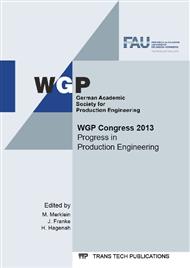p.173
p.181
p.189
p.197
p.205
p.213
p.221
p.229
p.237
Continuum Damage Mechanics (CDM) Based Local Approach to the Sheet-Bulk Metal Formability Prediction
Abstract:
Since sheet-bulk metal forming processes inherit properties of both sheet and bulk metal forming processes, their analysis requires on one side following certain methods conventionally devised in these process classes analyses whereas on the other side leaving certain customs out. For instance, inherent anisotropy of the rolled sheet has to be taken into account whereas due to non-vanishing out of plane stress component, analysis with thin shells using the plane stress state assumption is no more applicable. Similarly, methods based on necking instabilities, i.e. forming limit diagrams, which are typically used in sheet metal formability assessment; fall short in sheet-bulk metal formability prediction. In the present study, we propose a local approach to fracture, more specifically a phenomenologically based Lemaitre variant CDM model, devised frequently in bulk metal forming analysis, as an alternative. For this purpose, a combined nonlinear isotropic-kinematic hardening plasticity with Hill48 type initial anisotropy is fully coupled with isotropic damage. Together with the concept of effective stress and equivalent strain principle, quasi-unilateral damage evolution is used, where the energetic contribution of the compressive stress state to the damage driving force is scaled with a so-called crack closure parameter, . For the quasi unilateral damage evolution is inactive whereas for it is fully active which completely suppresses the development of damage under compressive stress states. The framework devises state coupling between elasticity and damage and kinematic coupling between plasticity and damage which increases the relative effect of on the eventual damage development. To this end, a direct extension to the finite strains for metal forming analysis is realized using a corotational formulation and the developed framework is implemented as a VUMAT subroutine for ABAQUS Explicit. For evaluation of the predictive capability of the model, teeth forming process results for DC04 reported in Soyarslan et al. 2011, An Experimental and Numerical Assessment of Sheet-Bulk Formability of Mild Steel DC04, Journal of Manufacturing Science and Engineering, Vol. 133 6, (2011) S. (061008) 1-9, are used. Mechanical material characterization studies are realized using a hybrid experimental-numerical procedure. This methodology relies on minimizing the difference between the experimentally handled global clamp force demand diagrams and the diagrams from the simulations at the complete range of the experiments involving fracture. As known finite element solutions with softening material models are prone to pathological mesh dependence. For this fact, a crack band method is used where the minimum element size, as a controlling parameter of the localization size, is also fitted through the characterization studies and identically used in the process simulations. The simulations show that a correct prediction of the zone and time of fracture is possible for the selected process whereas since the teeth formation process is mainly a compressive process, once the quasi-unilateral damage development is not used, i.e. for , a premature crack prediction is recorded which is not compatible with the experimental findings.
Info:
Periodical:
Pages:
205-212
Citation:
Online since:
September 2013
Authors:
Price:
Сopyright:
© 2013 Trans Tech Publications Ltd. All Rights Reserved
Share:
Citation:


